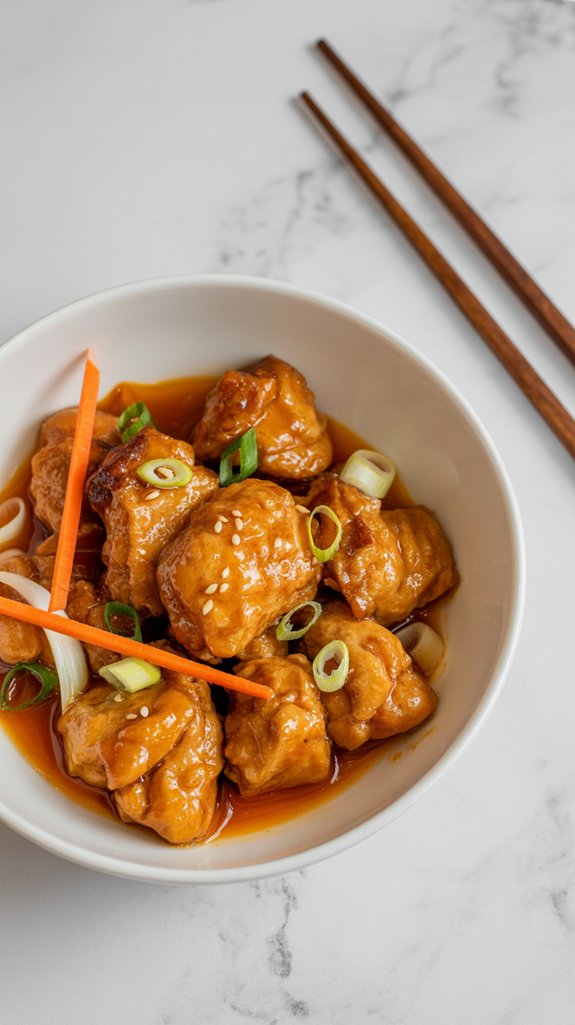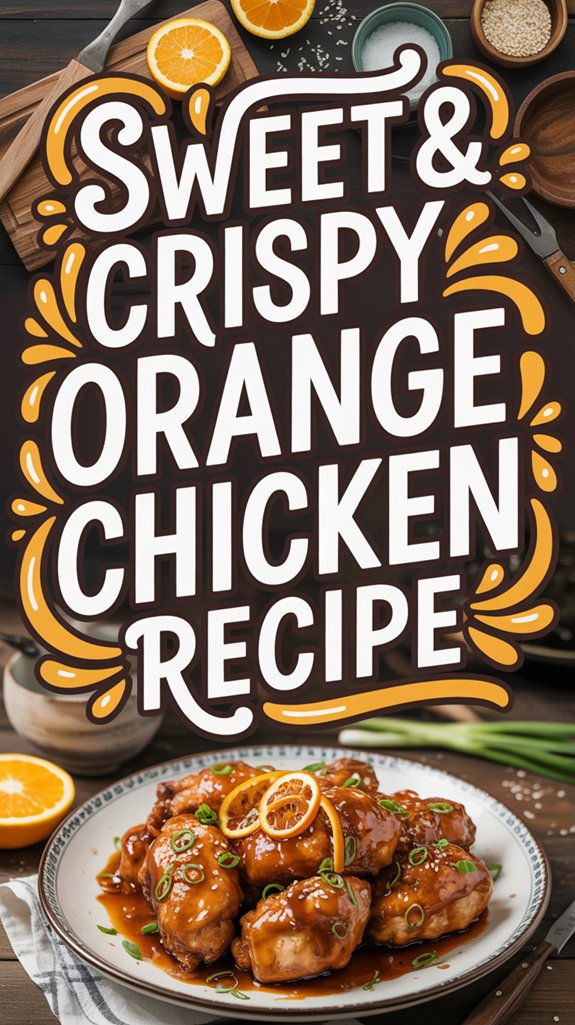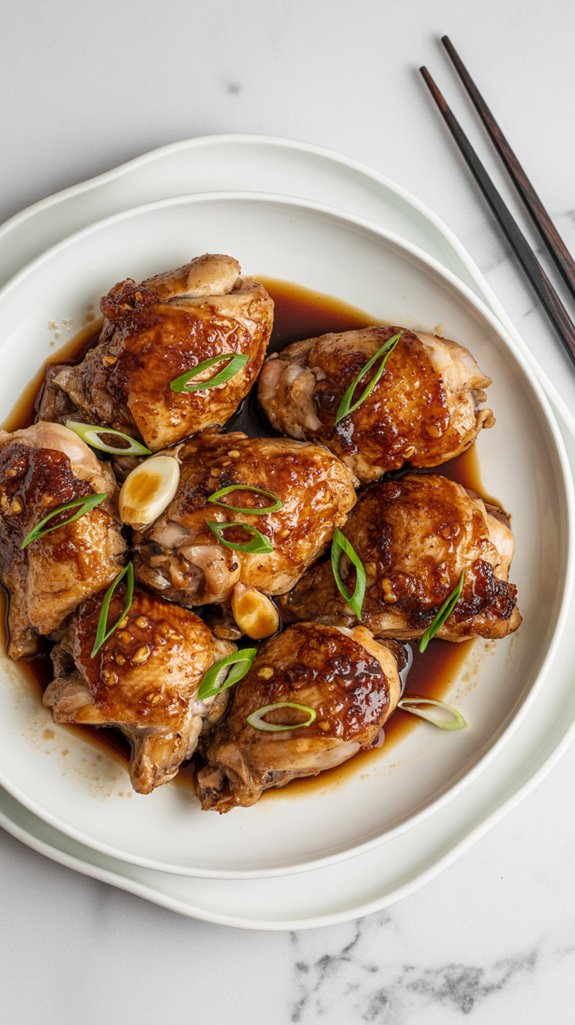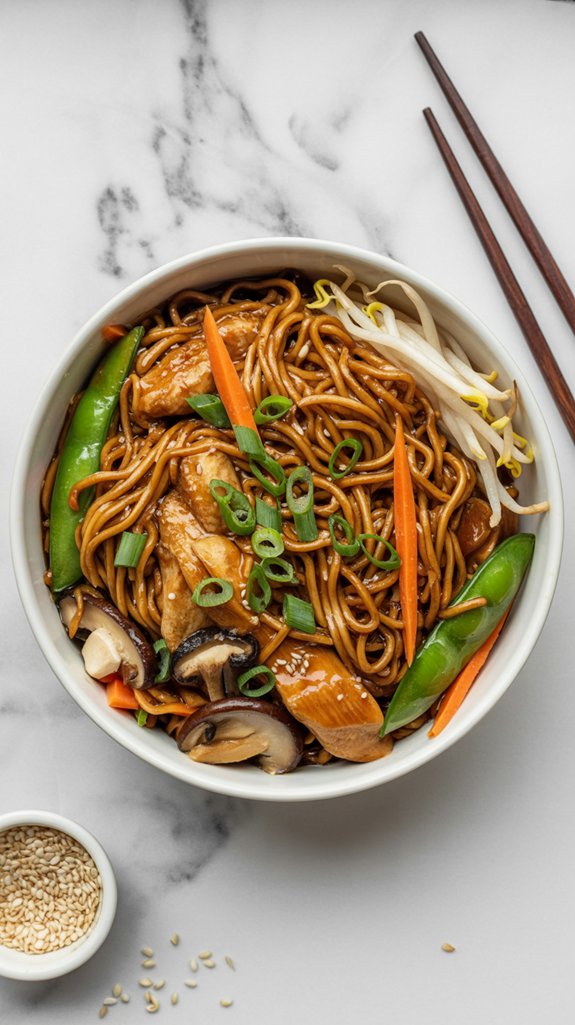Why You’ll Love This this Sweet & Crispy Orange Chicken
This orange chicken recipe delivers that perfect sweet-and-spicy balance you’ve been craving, with tender chicken pieces that get seriously crispy on the outside while staying juicy inside.
The sauce is where the magic happens though – it’s got this gorgeous glossy coating that clings to every piece, packed with aromatic garlic, fiery chilies, and that bright orange flavor that makes your taste buds do a little happy dance.
Trust me, once you bite into that golden, crunchy exterior and hit that saucy goodness, you’ll wonder why you ever bothered with takeout.
Ingredients List
Let me walk you through everything you’ll need to create this restaurant-quality orange chicken right in your own kitchen.
For the Chicken:
- 1 lb boneless skinless chicken thighs, cut into 1-inch cubes
- 1 large egg, lightly beaten
- Cornstarch (for coating and dusting)
- Cooking oil (about 4 cups for frying)
For the Sauce:
- 1/4 cup light soy sauce
- 1 tablespoon sake or dry sherry
- 2 tablespoons frozen orange juice concentrate, thawed
- 2 tablespoons spicy brown bean sauce
- 2 teaspoons minced ginger
- 1 teaspoon sesame oil
- 1 tablespoon cornstarch
For the Aromatics:
- 8 cloves garlic, minced
- 8-10 dried hot red chili peppers
- 1 orange (for peel)
For Serving:
– Hot steamed rice
A few things to keep in mind about these ingredients:
- Chicken thighs are naturally higher in fat than breasts, which keeps them juicy but adds calories
- The deep-frying method means this dish is quite oil-heavy, so it’s definitely more of a treat than everyday fare
- You can cut back on the chili peppers if you’re sensitive to heat, or add more if you’re feeling brave
- Brown bean sauce is high in sodium, so watch your salt intake for the rest of the day
- Using frozen orange juice concentrate gives you that intense orange flavor without watering down the sauce
Step by Step Directions
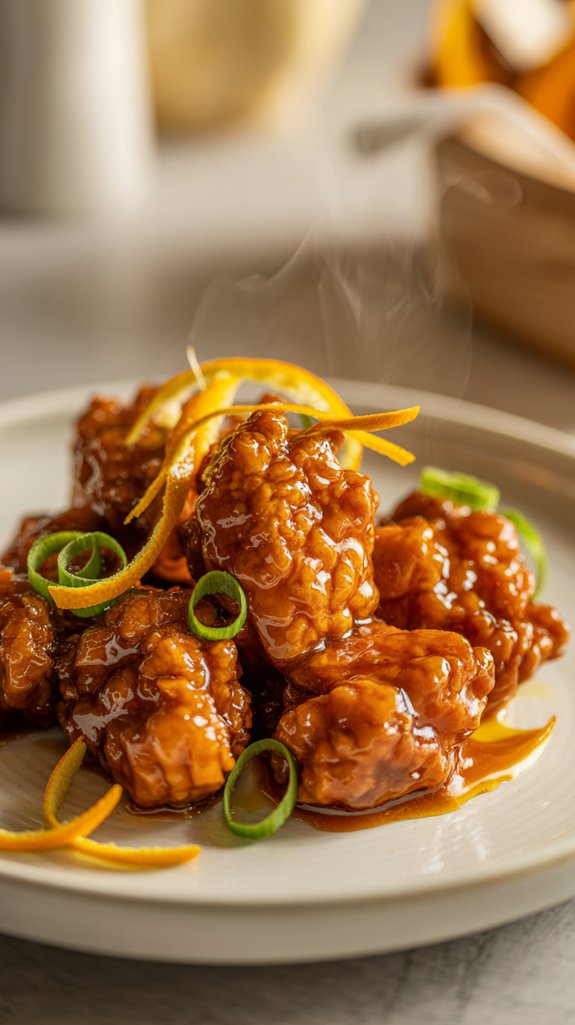
Making this authentic orange chicken involves careful preparation, proper frying technique, and timing to achieve that perfect balance of crispy texture and glossy sauce coating. Using a sharp professional chef knife will make the preparation steps more efficient and ensure clean cuts for both the chicken and orange peel.
- Prepare the chicken: Mix beaten egg with 2 tablespoons cornstarch, add chicken cubes, coat thoroughly, and let stand 10-15 minutes.
- Make the sauce: Combine soy sauce, sake, orange juice concentrate, brown bean sauce, minced ginger, sesame oil, and 1 tablespoon cornstarch in a small bowl.
- Prepare orange peel: Cut orange in half, then quarters, then eighths; carefully remove peel pieces, press flat, and scrape away white pith with knife.
- Heat oil: Heat 4 cups cooking oil in wok to 350°F.
- Fry chicken: Dust each marinated chicken piece with cornstarch, shake off excess, and fry in hot oil for 1½-2 minutes until lightly browned and crispy; remove and drain.
- Clear the wok: Drain all frying oil from wok.
- Build aromatics: Add 1½-2 tablespoons fresh oil to wok, add orange peel, dried chili peppers, and minced garlic; cook until fragrant and peppers start to darken.
- Create glaze: Add sauce mixture to wok and cook until thickened and glaze-like.
- Combine and serve: Add fried chicken pieces to wok, stir until well-coated and heated through (30 seconds to 1 minute), then serve immediately over hot steamed rice.
Substitutions and Variations
- Coating variations: All-purpose flour mixed with cornstarch works if you’re out of straight cornstarch, though you won’t get quite the same crispy texture.
- Oil substitutions: Vegetable oil or canola oil work perfectly fine for frying if peanut oil isn’t available, just avoid olive oil since it can’t handle the high heat.
- Make it gluten-free: Use tamari instead of soy sauce and make sure your brown bean sauce is gluten-free, or substitute with more tamari and a touch of sugar.
Additional Things to Serve With This Dish
While steamed rice is the classic companion, this saucy chicken practically begs for some variety on your dinner table.
- Fried rice – Because why not double down on the Asian flavors? Day-old rice works best, and you can toss in some scrambled eggs and frozen peas.
- Steamed broccoli or snap peas – Something green to balance out all that crispy, saucy goodness, plus the crunch plays nicely with the tender chicken.
- Chow mein or lo mein noodles – Turn this into a noodle situation, which honestly feels like cheating but in the best possible way.
- Simple cucumber salad – Just cucumbers, rice vinegar, and a pinch of sugar to cut through the richness.
- Steamed jasmine rice with sesame seeds – If you want to stick with rice but make it feel a bit more special.
- Asian coleslaw – Cabbage, carrots, and a sesame dressing that won’t compete with your star player but adds some freshness.
The beauty of this dish is that it’s pretty bold on its own, so your sides can be simple.
You’re not trying to create a five-course symphony here, just something that makes the orange chicken shine while giving your mouth different textures to play with.
Cooking Tips & Tricks (Chef’s Notes)
Getting this dish right comes down to a few key moves that’ll save you from soggy disappointment.
- Double-coat that chicken – The egg and cornstarch combo creates the base, but that second dusting right before frying is what gives you those gorgeous, craggy edges that hold onto sauce like they mean it.
- Oil temperature matters more than you think – Too cool and your chicken turns into greasy sponges, too hot and you get burnt outsides with raw centers, which is basically the worst kind of surprise.
- Don’t crowd the wok – I know you want to get everything done fast, but cramming all that chicken in there drops the oil temperature and ruins the whole crispy situation.
- Orange peel prep is worth the fuss – Getting rid of that white pith isn’t just busy work, it’s the difference between bright citrus flavor and bitter sadness in every bite.
- Sauce timing is everything – Have it mixed and ready because once you start the final stir-fry, things move fast and there’s no time to measure ingredients while your garlic burns.
- Cornstarch slurry trick – If your sauce isn’t thickening enough, whisk a teaspoon of cornstarch with cold water and drizzle it in while stirring, because nobody wants watery orange chicken.
- Leftover sauce storage – This stuff keeps in the fridge for about a week and works great on other stir-fries, just saying.
The whole dish hinges on that contrast between crispy chicken and glossy sauce, so don’t rush the frying step even when you’re starving.
Nutritional Facts
Based on the complete recipe serving 4 people, here’s what you’re getting per serving:
- Calories: 420-450 (varies based on oil absorption during frying)
- Protein: 28g – thanks to those meaty chicken thighs
- Carbohydrates: 18g – mostly from cornstarch coating and orange juice concentrate
- Fat: 28g – primarily from frying oil and natural chicken fat
- Sodium: 680mg – the soy sauce and bean sauce pack a salty punch
- Sugar: 8g – orange juice concentrate adds natural sweetness
- Fiber: 1g – minimal, since this isn’t exactly a veggie-heavy dish
- Cholesterol: 95mg – from chicken and egg in the batter
- Vitamin C: 15mg – decent boost from the orange components
- Iron: 2mg – chicken thighs are a solid source
- Calcium: 25mg – small amounts from various ingredients
The numbers jump considerably if you go heavy on the rice, and using chicken breast instead of thighs would cut about 50 calories and 8g of fat per serving, though you’d sacrifice some of that rich flavor.
Fun “Did You Know?”
Beyond those nutritional numbers lies a dish with some pretty wild history.
I’ve uncovered that orange chicken isn’t actually Chinese – it’s American-Chinese cuisine invented in the 1980s. The original creator, Chef Andy Kao, developed it at Panda Express to satisfy American tastes for sweet and tangy flavors.
What’s fascinating is that traditional Chinese cuisine rarely combines fruit with chicken this way. The dish became so popular that it’s now Panda Express’s signature item, selling over 100 million pounds annually.
It’s fundamentally America’s interpretation of Chinese cooking, proving how immigrant cuisines evolve to match local preferences.

